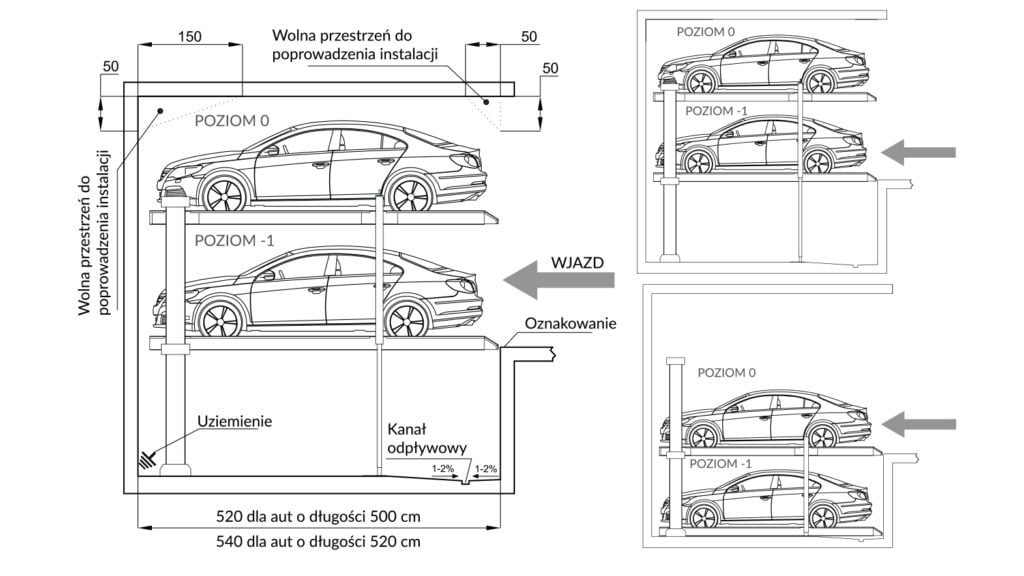When you park your car, especially in crowded city centers, you can often get the impression that day by day the number of cars on the road grows but the parking available remains the same. This is confirmed by worldwide research and analysis – we buy more and more vehicles and the space in cities and even suburban areas does not grow. Does this mean parking spaces will soon run out? Fortunately, thanks to the use of parking platforms, this is unlikely. The number of cars per capita is steadily increasing in almost every country in the world, and there is no indication that even increasing people’s concern for the environment or the rising fuel prices will stop or even slow this trend. Car manufacturers are racing to design and promote hybrid and electric solutions, which are gaining popularity. This in turn will most likely not cause the number of cars on the road to reduce and instead will just increase the market share of this type of vehicle with less environmental concerns, etc.
The real estate market – both residential and commercial – is also developing intensively. The result is an ever-increasing demand for parking spaces with parking becoming a problem not only in the city center, but even on our own personal properties where we often have two, three or several cars in the household. This situation can also be compounded when you consider different people needing their cars on different times and a continuous re-shuffle of the cars on the driveway.
To address this problem, architects and developers are increasingly seeking a modern-day solution: parking platforms. Thanks to this technology, we can make the most of the available space and provide the right number of parking spaces for the investment. How? By allowing several cars to be parked, utilizing the area of only one standard parking space.Parking platforms Parking platforms are a very functional solution, having been available on the market for quite some time and increasingly used across the world.
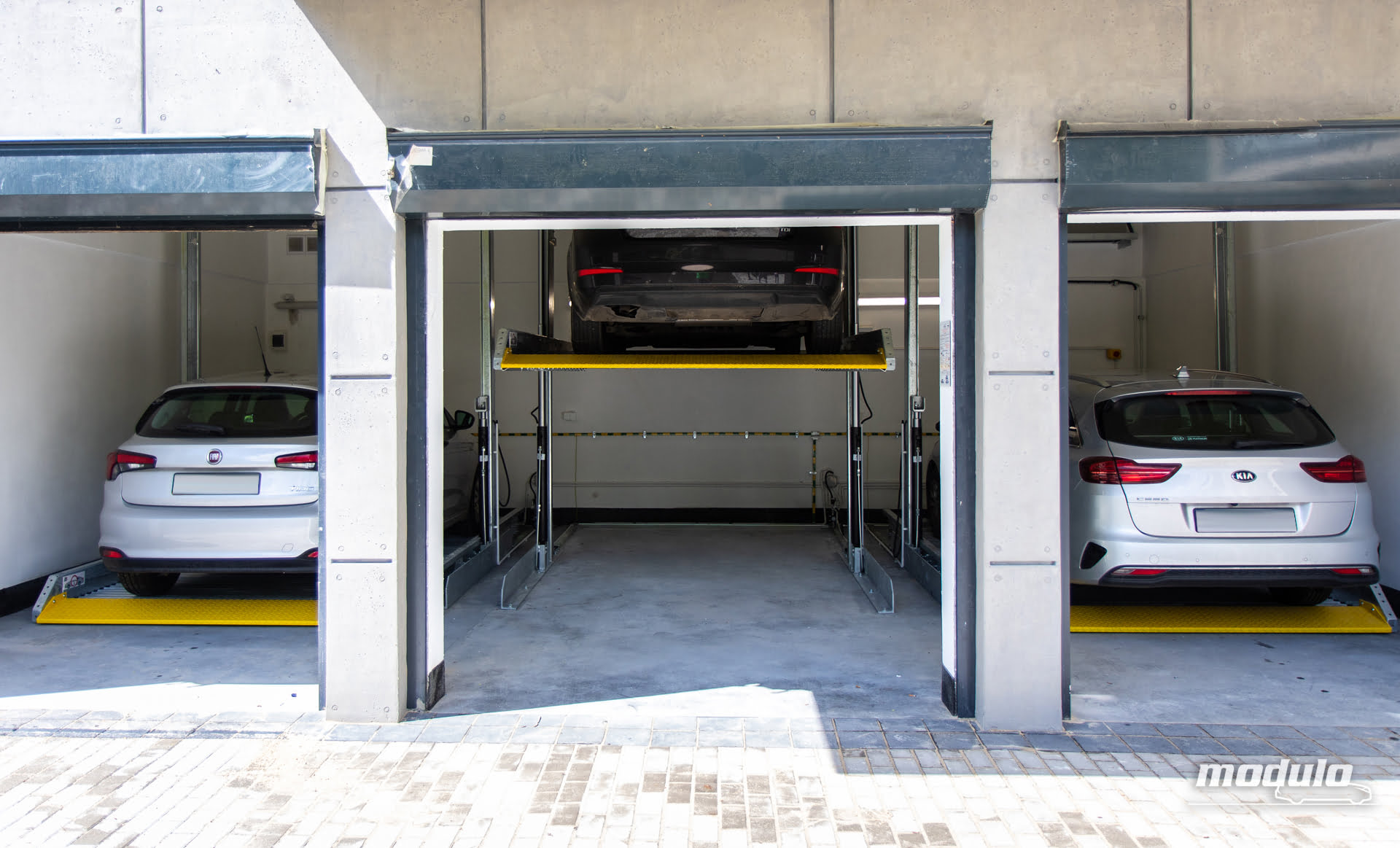
Dependent parking platforms Modulo Stacker-P10 in the garage above ground
Simply put, parking platform is a device that allows you to park two or more cars on the surface of one standard parking space. This is made possible by the design of the device – systems based on parking platforms are nothing more than advanced, multi-level floors, which, after parking the vehicle, raise or lower it. Another car can then be parked in the original place without any obstructions.
However, if you need to make a pit or a higher garage, the question may arise as to whether the systems are actually space saving? The answer is most definitely yes, because the space into which the car must be raised or lowered must be only as much as the height of the car plus the necessary components of the device.
This means that to install a parking platform that allows you to hide “underground” a car with a height of up to 170 cm we need a pit with a depth of only 190 cm. Thanks to this, with only two additional meters, we gain double the number of parking spaces over the entire parking space. This is incomparably more convenient and economical than adding additional level of an underground garage, which is often simply impossible due to construction conditions, for example, high groundwater.
Parking platforms are available in many variants, allowing you to adjust the solution perfectly to be adapted to the characteristics of a given investment or location. In principle, they can be divided according to several criteria related to both the way of use, control, and the form of available parking spaces.
The primary and most relevant division from a user perspective is dependent and independent parking platforms. RDependent solutions usually consist of a single parking platform placed on poles anchored to the floor and sometimes also to walls or adjacent devices. Their use consists in lifting the platform with the car parked on it upwards, so that on the space below can be available for another car.
Entry or exit of the upper vehicle in this case is dependent on whether the space below is vacant. Examples of such a solution are Modulo Stacker-P, very readily used in small businesses or small residential buildings, or Modulo Stacker-V often used in backyard garages, due to its small size and design, allowing two vehicles to be parked even in a low garage.
Dependent parking platforms are characterized primarily by a lightweight design and simplicity of installation, which makes them an ideal solution for home garages, small businesses, or small residential buildings. Due to the need to free up the lower parking space first so that the upper one can be used, this solution is intended for people who leave their parking spaces in a regular order, such as employees of a single company. This type of platform will also work for customers with two vehicles, one of which is used much less frequently (antique or collectible).
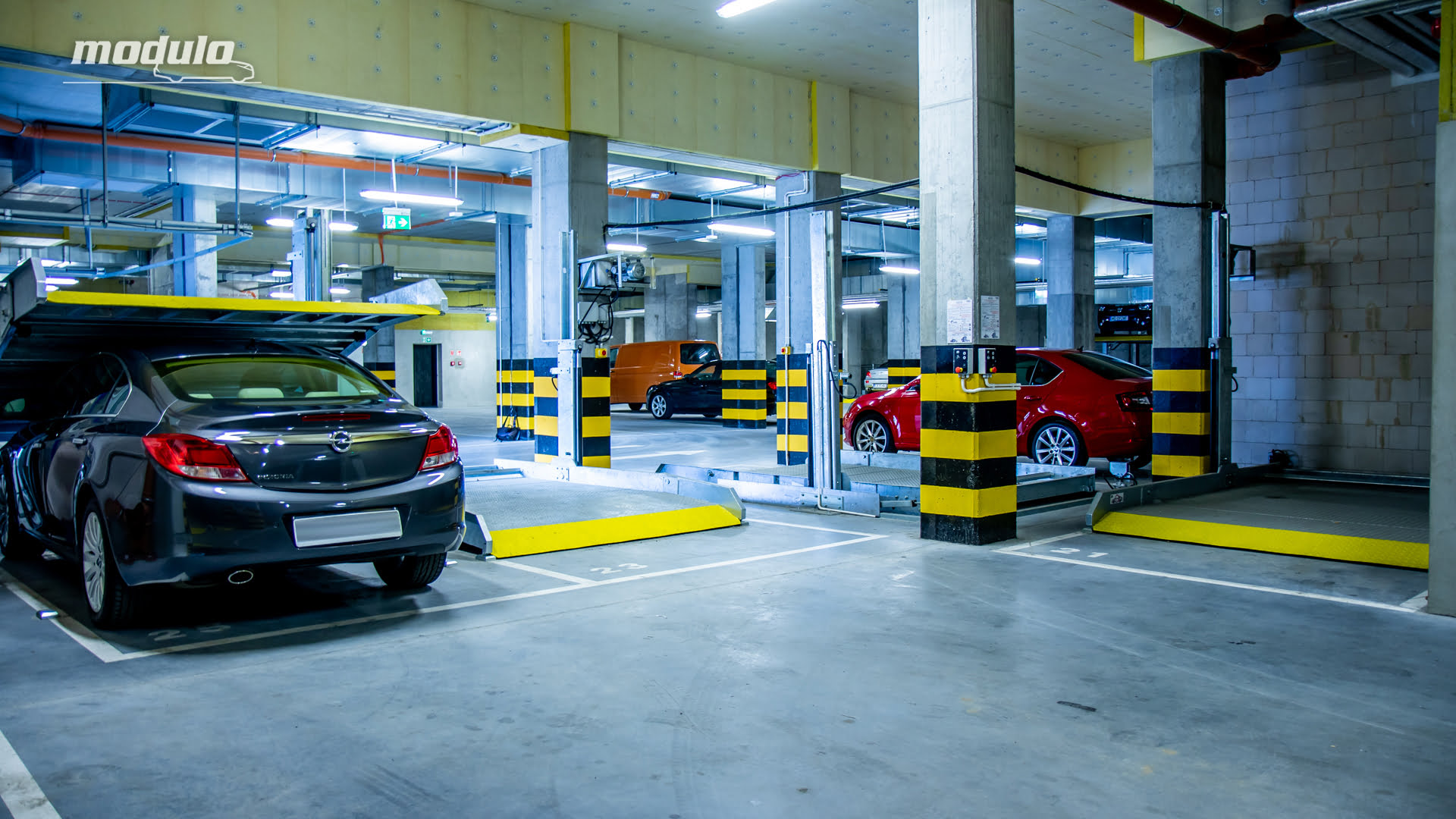
Dependent parking platformModulo Stacker-V10
Independent parking platforms is a solution most popular with developers and architects. The design of this type of platform allows you to use any parking space regardless as to whether the others are occupied. On one standard independent device we can park from two to four cars, and in the case of modular and semi-automatic solutions it can be from several to even dozens of vehicles. Thanks to the use of a specially made pit or semi-automatic system moving parking spaces vertically and horizontally, we can hide the car below the access road or raise it to a higher level and slide it horizontally. Freeing up space for another car in the original space. Independent platforms are most often used on housing estates, development projects and public facilities such as hospitals and airports. An example of one of the most popular parking platforms used by developers is the Modulo Parker-C100, a very versatile system that allows you to park from two to four cars. It is characterized primarily by the convenience of use and the possibility of exceptionally large adjustment in both the width and height of spaces according to the individual needs and preferences of the customer.
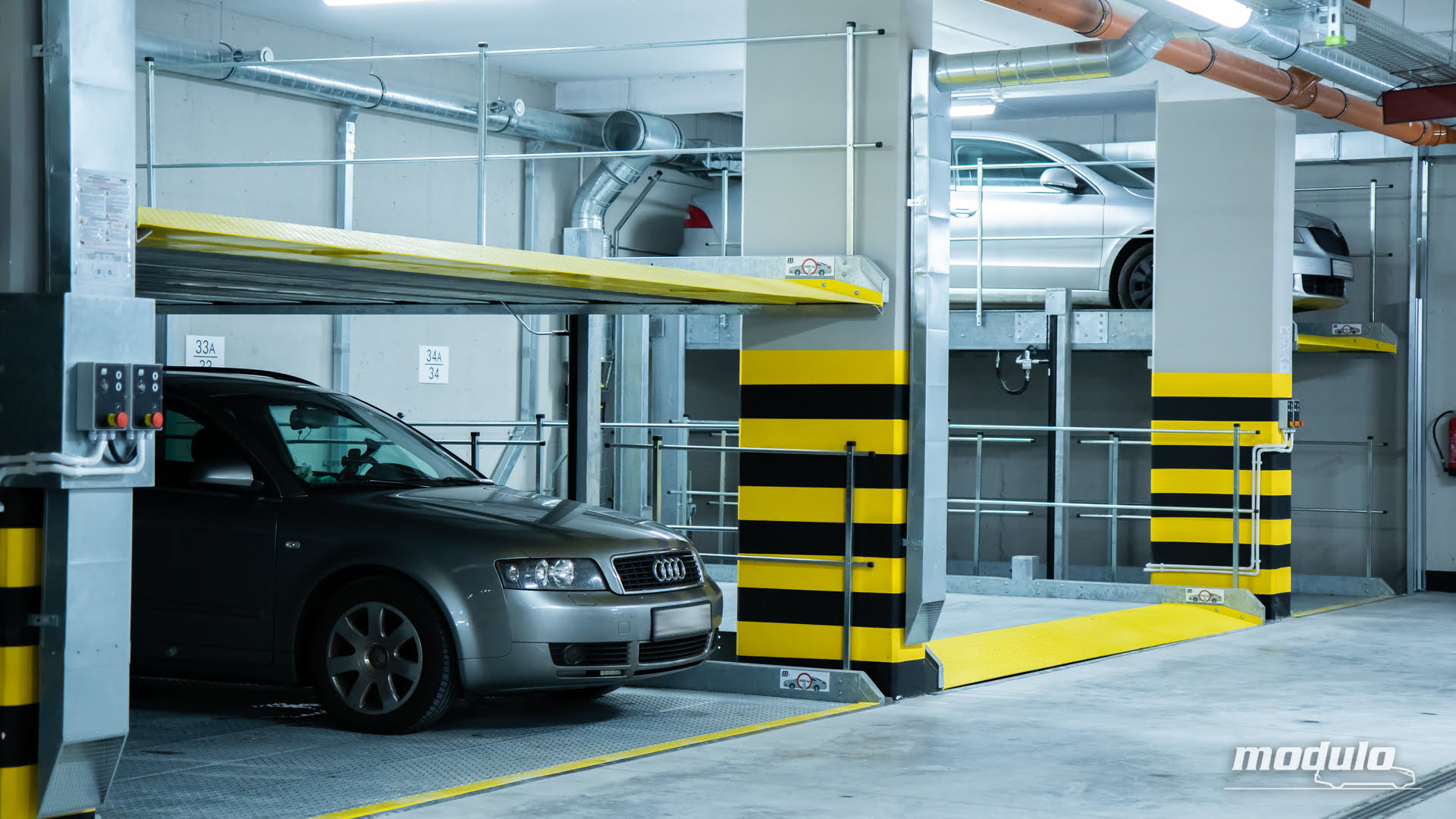
Independent parking platforms MODULO Parker-C100
Another way by which we can divide the parking platforms is the amount of parking levels offered by the device. Most standard dependent solutions include parking at levels 0 and +1 and independent at levels -1 and 0. In addition, we also distinguish single- and multi-level solutions. The first, is most commonly based on rotating platforms and allows you to increase the number of parking spaces without having to make a recess or having a sufficiently high garage hall. Thanks to the use of platforms moving in the X or Y axis, on which cars can park, we can allow parking in places at the back, without the need for access roads to them. Such solutions allow you to park up to twice as many vehicles as when we set up standard parking spaces. An illustration can be the following figure, showing how the Modulo Pallet operates:
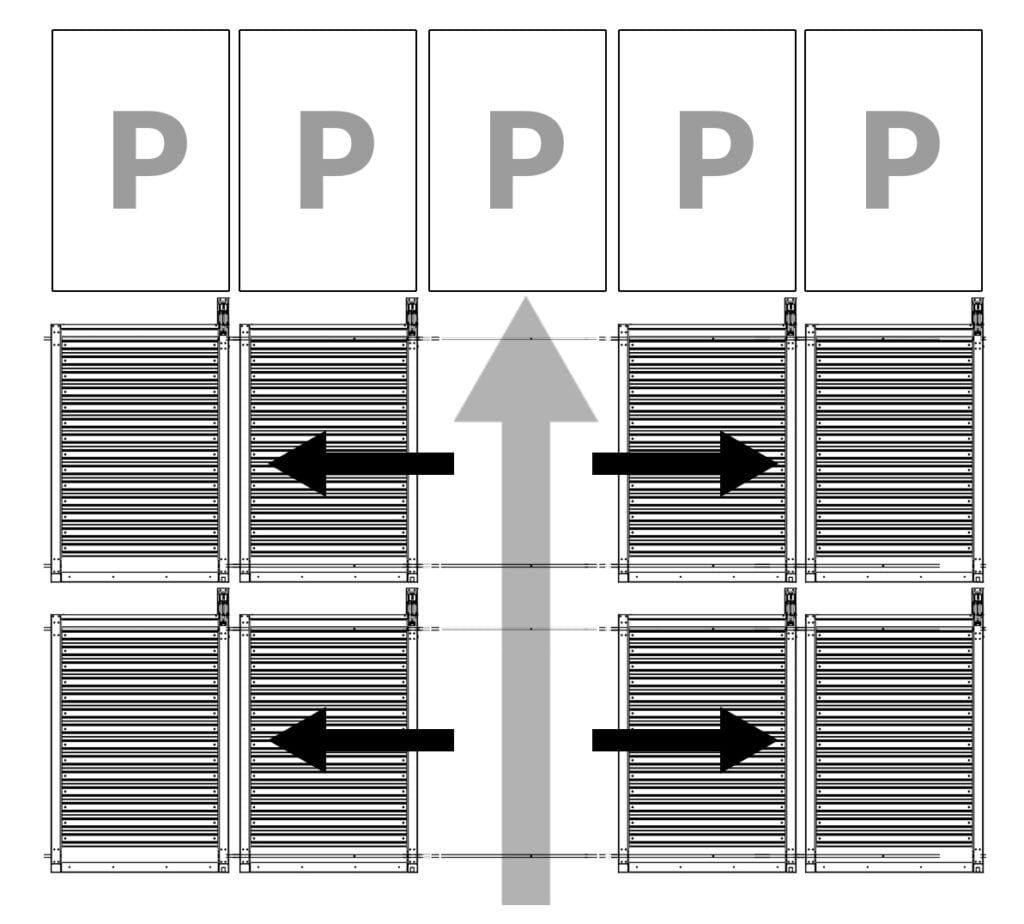
Use of sliding platforms Modulo Pallet to use the access road as parking spaces
Multi-level solutions are usually advanced semi-automatic car parks. They allow you to take advantage of 3 or more parking levels at the same time and offer many options for configuring the number and layout of parking spaces. An example would be Modulo LS which allows you to use up to three levels of parking, from -1 to +1, or Modulo LSM, which gives the possibility of expanding upwards from level 0 to even +5. In this type of solution, level 0 platforms move to the right and left, while the others move up or down, allowing you to use any parking space independent of the others. Multi-level systems allow for the construction of up to several dozen parking platforms on the surface of only a few standard parking spaces. In addition, they can both be an independent object or be integrated inside the building, which gives great design possibilities to architects.
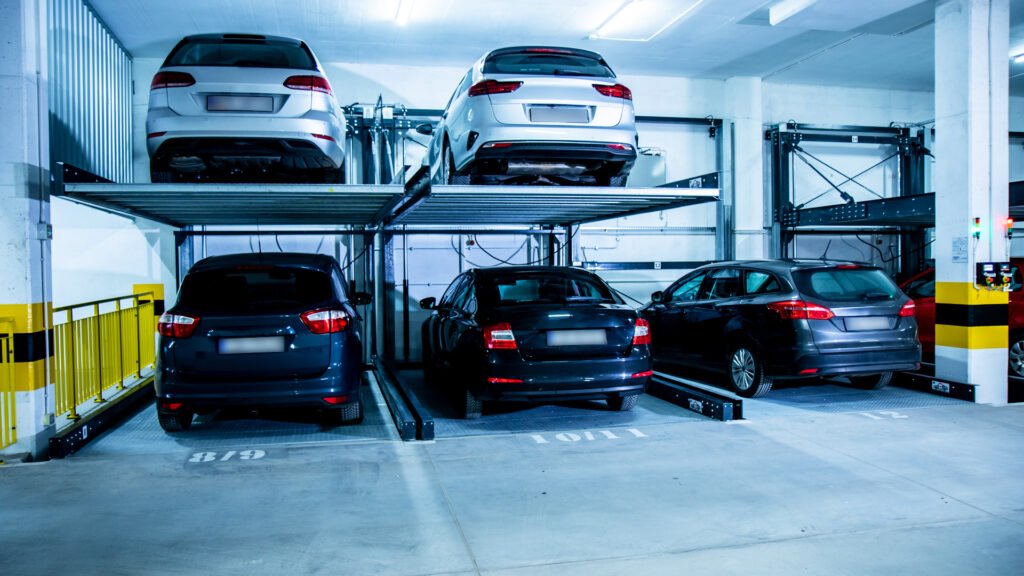
Semi-automatic parking platforms Modulo LS
It is also worth mentioning one more way of dividing parking platforms – because of the way they are controlled. Most often we will see devices controlled by means such as “hold to start” – in this case, if it is necessary to raise, lower or call a particular platform, the driver must do so before parking the car using the control panel located next to the device. The process itself is extremely simple and usually requires only selecting and holding the number of a specific parking space (for devices that offer multiple platforms) or an up or down arrow that allows you to pick up or leave the platform (for standard dependent and independent solutions).
However, this is not the only possibility – in particular, semi-automatic parking platforms allow the installation of gates and advanced control systems, enabling their operation even remotely, with the help of a remote control or even a dedicated application controlling the parking. The last type of division worth mentioning is external and internal parking platforms. It should be noted, however, that it is only theoretical since it is only dependent on the installation site. In theory, any platform solution can be installed outdoors, preparing the area around it accordingly. But this does need deeper consideration as is connected to the systems production, power supply and exposure of the components to moisture and frost and thus in most cases this is not recommended. However, this does not mean that external installation is impossible – almost any standard solution can be designed to have increased weather resistance and guarantee long-term and trouble-free outdoor use. Usually, however, this involves the need to carry out an individual project, or additional protection in the form of walls or roofing for the systems. The exception here is parking platforms already designed primarily for outdoor installation, such as Modulo Parker-O. In addition to its adaption for outdoor use, it has another unique advantage which is very desirable, especially for individual customers with the possibility of adapting the device to the environment. The entire structure of the platform hides underground and due to the absence of any protruding elements, the upper platform can be prepared so that it “blends” into the environment. Demanding customers can even arrange it to be part of an access road finished with paving stones or gravel.

Modulo parking platform Parker-O100installed outside the building
The design of parking platforms from the user’s perspective is amazingly simple. In fact, the essential components are only the platform itself and the control panel of the device. Of course, these are not the only elements – the device also includes electrical systems, a hydraulic unit or an electric motor, wires and many other components, but these are not details that a person parked on the platform must know or be able to distinguish between. The control panel always has three key elements: a key to start the device, control buttons and a safety button. The first element does not really have to take the form of a key in the traditional sense. It can be successfully replaced with a contactless solution in the form of a card or fob. The most important thing here is that each parking platform has its own individual key, which allows it to operated only by the authorized person. The control buttons, depending on the type of device, allow you to call, raise, or lower the platform. The red safety button, on the other hand, is used to immediately interrupt the operation of the device in case of any danger. For the user, the parking area within which the vehicle must fit is crucial. Proper positioning and entry is facilitated by color indication from the rest of the platform, slightly raised sides marking the edges of the parking space and above all, a platform-mounted bumper. Which determines how far the vehicle can enter the system using the front or rear wheel ensuring the car does not protrude beyond the edge of the device..

Intuitive and user-friendly control panels for parking platforms
Parking on platforms is amazingly simple and intuitive. When the device is unlocked, depending on the type of control panel, the lights under the buttons will turn green or the display will turn on. If this is the case and we do not see any error message it means that we can start moving the platform or call our parking space. We do this always by selecting a specific space number assigned to us or by holding the up or down arrow button depending on whether you want to raise or lower the platform. Always hold the button until the platform has fully completed the movement – there is no fear that it can be held for too long. The sensors installed in the device will always stop them when the parking platform is in the maximum upper or lower position. After calling the platform, we can enter or leave by car to our parking space. There are no additional steps or necessary actions, and the parking process itself is extremely simple and fast. Although the operating time may vary depending on the type of device, the number of parking spaces and the weight of the vehicle. The two most important advantages that are crucial for the use of platforms are convenience and security. Very often, among people who first encounter this type of solution, there are remarkably similar concerns about how it works. The most common concern for new users is what happens if they can not start the platform and how likely they are to lock the platform in place. This is usually extremely rare. Of course, like any mechanical device, the parking platform can also fail but more often than not failures are due to oversights resulting from its use. First of all, however, it should be remembered that each parking platform has both hydraulic and electrical protections significantly reducing the risk of any failure and eliminating situations that the platform will automatically fall or go up. As we have already emphasized, the operation of parking platforms should not cause concerns for anyone. In addition, each user is always fully trained, and with each device there is instructions for use and safety rules.

Łagodny najazd, precyzyjnie wytyczona przestrzeń do parkowania oraz barierki ułatwiają korzystanie z platform parkingowych
Parking on our platforms is often more convenient than in standard parking spaces. Due to the precise restrictions of the space, there is no risk of someone parking the car incorrectly. Now accidently taking up one and a half spaces is impossible. In addition, manufacturers of parking platforms very often use solutions that significantly increase the comfort of use. Examples include Modulo Parking platforms, where exceptionally durable barriers surrounding the entire platform and illuminated buttons on the control panel are standard, which intuitively inform the user about the condition of the device using the appropriate color. Special variants of parking platforms can have even more comfortable improvements such as increased width and height of the parking space or the construction of the entire platform from flat checkered plate steel, which in addition to non-slip properties makes it much easier to move on foot on the platform, regardless of the type of footwear worn.Parking platforms are undoubtedly the future of parking not only in cities, but also residential garages. Platform solutions are primarily user-friendly and from the perspective of a designer or developer, a much cheaper and more efficient option than making additional levels of parking or outdoor parking spaces. Every driver is primarily concerned with vehicle safety and parking comfort, which, with the increasing number of cars, can undoubtedly only be provided by parking platforms.


